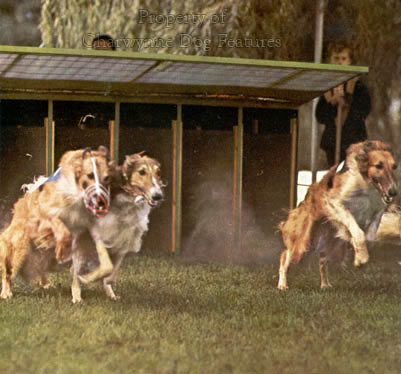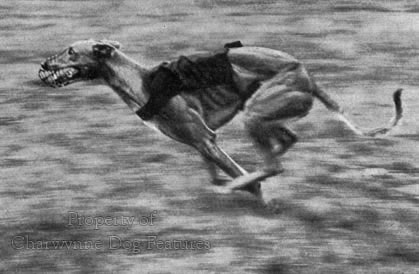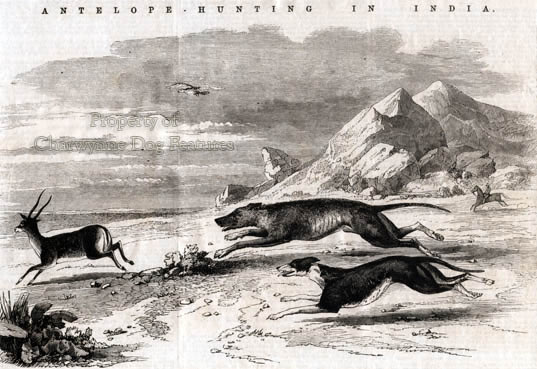111 THE POWER OF THE SPEEDSTERS
THE MAKE-UP OF THE SPEEDSTERS - Power and Perception
by David Hancock
 The hounds that hunt using their speed have become known as sighthounds, which is a pity in many ways, for all hounds hunt using their noses too, and scenthounds definitely use their eyes! The German word for sighthound is ‘windhund’ and their expression ‘von Wind haben’ means to get wind of; in some ways that is better, for whether by sight or scent, all sporting dogs become aware of their quarry by getting wind of it. Hunting by speed depends on the pace of the dog and its willingness to speed after a fast-moving quarry. Sighthounds without hard muscle and an alert eye are a sad sight, to me they have simply lost the will to live as sighthounds. To develop a type of dog to excel at a particular function, with a specially designed physique to do so, and then let it waste away is a betrayal. To deny it the chance to run fast is a form of indirect cruelty; that is what it’s for! It’s therefore cheering to hear not just of Greyhound Racing but of Whippet and Lurcher racing, and of Afghan Hound racing being conducted too.
The hounds that hunt using their speed have become known as sighthounds, which is a pity in many ways, for all hounds hunt using their noses too, and scenthounds definitely use their eyes! The German word for sighthound is ‘windhund’ and their expression ‘von Wind haben’ means to get wind of; in some ways that is better, for whether by sight or scent, all sporting dogs become aware of their quarry by getting wind of it. Hunting by speed depends on the pace of the dog and its willingness to speed after a fast-moving quarry. Sighthounds without hard muscle and an alert eye are a sad sight, to me they have simply lost the will to live as sighthounds. To develop a type of dog to excel at a particular function, with a specially designed physique to do so, and then let it waste away is a betrayal. To deny it the chance to run fast is a form of indirect cruelty; that is what it’s for! It’s therefore cheering to hear not just of Greyhound Racing but of Whippet and Lurcher racing, and of Afghan Hound racing being conducted too.
In a recent report on an Afghan Hound race meeting near Liverpool, these words were used in the introduction: “Those of you who have never taken your dogs racing – you really do not know what you are missing – find your nearest meeting and go along and see what happens. They – and you! – deserve the fun.” This meeting was attended by 22 Afghan Hounds and 27 others: 4 Lurchers, 4 Pharaoh Hounds, 3 Salukis as well as Whippets, Border Collies, Siberian Huskies, even Jack Russells and 5 Border Terriers. In the 260s, the best Afghan time was 22 seconds; in the 440 metre run timings varied between 45 and 55 seconds; with some sub seven-second times in the 100 metres. What fun and yes, the dogs do deserve it!
At the Whippet Club Racing Association Bend Championships held in the Cotswolds five years ago, 130 dogs ran on a horseshoe-shaped 240 yard track in 9 different weight groups, with a fastest time of 14.9 seconds. Until coursing becomes legal once again, what a great way to keep the speedsters tried and tested. 
A Greyhound can cover 5/16ths of a mile in 30 seconds. In each decade the feats are repeated: in 1932, Ataxy did 525 yards in 29.56 seconds, and, in 1936, 725 yards in 41.69 seconds. In 1971, Dolores Rocket did the 525 yard course in 28.52 seconds. In 1944, Ballyhennessy Seal set what was then a new world record for 500 yards in 27.64 seconds. The legendary Mick the Miller did the 600 yards in 34.01 seconds in 1930. He was spoken of as combining 'tranquillity with trackcraft'. In other words he never wasted energy nervously and used the circuit cleverly. When he died he was found to have a heart weighing 1½ ozs above the normal for a Greyhound of his size.
Of course hounds with a comparable build can also achieve great speed; a 32lb Whippet was once recorded as covering 150 yards in 8.6 seconds. This build is a superb combination of bone and muscle, a unique balance between size/weight and strength and quite remarkable coordination between fore and hind limbs. The Greyhound sprints in a series of leaps rather than running in a strict sense. It is what is termed a 'double-flight' runner, where the feet are all off the ground at the same moment. This is unlike a 'single-flight' animal like the horse which, when racing, nearly always has at least one foot on the ground.
The Greyhound's leaping gait is rooted in quite exceptional extension, especially forward with the hind legs, but also rearwards with the front legs. Anatomically, the most vital elements in such a dog are the shoulders, and their placement, and the pelvic slope, which determines the forward extension of the all-important hind-limbs. That's where the power comes from. It always saddens me to see a sighthound in the show ring displaying upright shoulders and short upper arms, together with a lack of pelvic slope. It is even sadder when such an exhibit is placed by an ignorant judge! I see these faults especially in Afghan Hounds, but also in Salukis, Borzois and Whippets, as well as in lurchers at country shows..jpg)
But I do see more correctly-constructed 'Greyhound-Lurchers' than I do show Greyhounds. This is a comment rather than a criticism, because I see many more of the former than the latter. It is worrying however to see a lack of muscle on show Greyhounds and at times a slab-sidedness which affects type as well as function. Sporting breeds must be judged in any ring on their ability to carry out their specific historic function, if not then there is really little point in breeding them. This ability was summed up by the esteemed ‘Stonehenge’, when writing on the Greyhound over a century ago: “This framework, then, of bones and muscles, when obtained of good form and proportions, is so gained towards our object; but still, without a good brain and nervous system to stimulate it to action, it is utterly useless; and without a good heart and lungs to carry on the circulation during its active employment, it will still fail us in our need.” Running dogs need heart in every sense.
The particular function of each sporting dog not surprisingly led to the development of the physique which allowed the dog to excel in that function. That is why sighthounds have a muscular light-boned build, the terriers a low-to-ground anatomy and the flock guardians substantial size. Sighthound breeds, wherever they were developed, project the same silhouette, display the same racy phenotype. The Azawakh of Mali, the Harehound of Circassia, the Sloughi of Morocco and the Tasy or Taigon from Mid-Asia would never change hands if they didn't look like fast-running dogs. If they didn't possess this anatomical design they couldn't function as speedsters. The ratio of weight to height matters when speed with stamina is sought.
The weight of successful coursing Greyhounds is worth a glance. The renowned Master M'Grath was around 53lbs, Bit of Fashion was 54lbs, Golden Seal, Staff Officer, Guards Brigade, White Collar and Fitz Fife were each around 65lbs but Shortcoming only 49lb. Our show Greyhound has no stipulation regarding weight but its ideal height, for a male dog, is desired at 28-30 inches. A Deerhound dog of 30 inches at the withers would weigh around 100lbs. Does a Greyhound need to be 30" high and approaching a hundredweight? Why does a show Greyhound need to be twice the weight of a successful coursing Greyhound? The American KC standard sets the Greyhound's weight at 65-70lbs for a dog and 60-65lbs for a bitch. I don’t believe that the giant lurchers I see at some country shows are effective speed-hunters.
Hunters and sportsmen the world over know that the ability to catch game using speed demanded a very distinctive build. The sighthounds bound; they must have the height/weight ratio, the leg length and the liver-size to sprint. Sighthounds race entirely on liver glycogen, sugar activated from the liver. Sprinting demands long legs and a sizeable liver. The bigger the liver the more sugar can be stored. A sighthound over 65lbs in weight would have a problem through heat storage; their streamlined build allows a greater surface area. We are good at getting rid of excess heat and not very good at storing it. Dogs are the reverse, removing excess heat from their surfaces rather as a radiator gives off heat.
When sighthounds were traded, these technicalities were not known but the radiator-like build, size without weight and long legs meant something to their traders. The most successful sprinters had the build to succeed and were traded and perpetuated. In breeding for appearance only we need to bear in mind those anatomical essentials that made sighthounds what they are: internationally renowned sprinters. An 85lb Borzoi will experience difficulties when running flat out; a Greyhound of any weight with a small liver will have an even bigger handicap. Traders in such hounds couldn't measure livers but they could measure performance.
Studies on the blood of the Azawakh and the Sloughi showed that both have an additional allele on the glucose-phosphate-isomerase gene locus not found in other sighthounds and dogs but present in the coyote, fox and jackal. These two African breeds showed the greatest genetic distance from the other dogs in this study. This suggests a different historical development. At a distance it is not easy to tell a smooth Saluki from a Sloughi or indeed an Azawakh, such is the phenotypal mould, developed through function, function as a speedster. Some of these overseas breeds are being perpetuated here only in the show ring. The worry is that, in time, show ring criteria will shape them, not function. If you look at the Afghans first imported here and then compare them with today’s breed, you can immediately spot the heavier coat, with upright shoulders and short upper arms featuring too.
It is so pleasing to know that Afghan Hound (and Saluki) racing is conducted in Britain; what a release for the hounds! Less pleasing is the knowledge that the best Afghan Hound racer, Fox Ellis, which won the national individual championship a record five successive times, was never used at stud. A litter sister became a champion but for Fox Ellis not to be used at stud tells you more about breeders seeking show-winner blood ahead of proven construction than I ever could. The sighthound breeds only survived to enter the show arenas because of their ability to race. 
In 2009, two show judges’s critiques on Afghan Hounds depressed me; one read: “The more I observe modern day judges, the more I come to the conclusion that many seem to have little conception or complete lack of understanding of ‘true type’.” The second read: “So on to the most major problems which are prevalent no matter where one looks…You either have to accept it or stand alone in an empty ring.” What sad reading! The grooming fetishists have prevailed in this breed and this insults the painstaking work done by primitive hunters in unforgiving terrain over many centuries in their native country. Our noble infantrymen sweating away in Afghanistan today would much prefer not to have to wear body armour, bulky equipment round their waists and carry packs on their backs. Afghan Hounds don’t need a similar hindrance on their bodies!
Muscular power and energy storage apart, the speedsters of the dog world need superlative eyesight. Dogs easily outperform humans in detecting movement, their motion sensitivity allowing them to recognize a moving object from a distance of 800-900 metres away. Motionless, the same object will only be picked up by the dog’s vision at roughly half that distance. Dogs have far superior peripheral vision to us, around 250 degrees, against our 180 degree maximum. All animals active at night, whether predators or prey, have a ‘back-up’ visual support system, which gives the retina two opportunities to catch light, greatly enhancing night vision. A highly reflective layer of cells, the tapetum lucidum, underlies the retina and behaves like a mirror. Light is reflected back through the retina, the tapetum offering the photoreceptors a second chance to capture light. This mirror effect, reflecting light back out through the eye, makes predatory animals’ eyes shine in the darkness. Photographs of them pick this up. Dogs’ low-light vision is far superior to that of humans but is still not as good as the cat family, which detects light levels six times dimmer than our eyes can. Great muscular power and keen eyesight; without either hunting by sheer speed would not be possible and both qualities need to be bred for and respected - for some their hunting dog is the difference between eating and starving. Their dogs are never judged on their appearance!